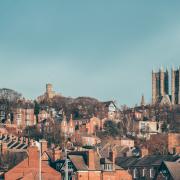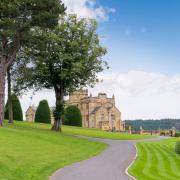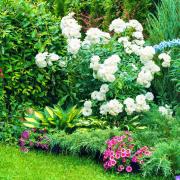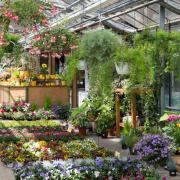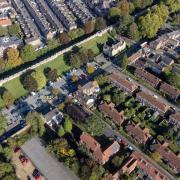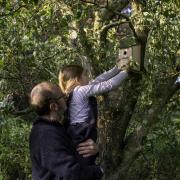The Herb Gardens at Bolton Castle near Leyburn have been revitalised ready for the new season. Kendra Grahame-Clarke investigates this hidden gem that has been a labour of love for gardener Elizabeth Carter
Nestled in the hills of Wensleydale in North Yorkshire, the gardens at Bolton Castle are a testament to the history of the castle with some small 21st century designs added to the mix. Mary Queen of Scots came here from Carlisle Castle and was held here for some six months before removal further south. She may well have looked down on the gardens at Bolton Castle and seen little difference in today’s plantings. Much of what we can see today is thanks to gardener Elizabeth Carter who has worked at the castle since 2015.
Reinstated following an archaeological survey in 1994, the legacy of the medieval period is celebrated with the design adhering as much as possible to the principles of medieval horticulture. The original garden covered an area of nearly 20 acres, overlooking the ancient Forest of Wensleydale, and over the years the gardens evolved to fit with every castle incumbent.

They were reinstated by Lord Bolton following an archaeological survey in 1994 with the legacy of the medieval period celebrated in the design, adhering as much as possible to the principles of medieval horticulture. Now divided into walled sections, the castle looks down on a maze, a small but perfectly formed vineyard, the Mary Garden (or Catholic Garden) planted with traditional flowering plants associated with Our Lady, the Dyers Garden with a range of plants for dyeing cloth; and the sunny Herb Garden with culinary and medicinal herbs, which has now benefited from the focus of gardener Elizabeth.
Built as a luxurious home by Sir Richard Le Scrope 600 years ago, Bolton Castle is one of the best preserved medieval castles in the country and uniquely remains under the private ownership of Lord Bolton, a direct descendant of Sir Richard.
Elizabeth’s career was set in music and the arts before she changed direction to set up a complementary therapy business, which includes her being registered as an advanced and leading practitioner in the Bach Flower Remedy medicinal system. Elizabeth’s zeal to revitalise the herb gardens has been what can only be called ‘steely’ and she is looking forward to sharing her knowledge with visitors.

Tom Orde-Powlett, whose family own the Bolton Estate, which includes Bolton Castle, recognises that Elizabeth's work has been a labour of love.
‘These unique garden 'rooms' now truly reflect the lives, needs and beliefs of its medieval incumbents through the centuries. They are a window on the world of all those who lived here,’ he says.
Elizabeth certainly felt the pull of history and the project has taken more years than she imagined, resulting in the herb gardens now set out as a ‘physic garden’, with over 100 different types of plants that might well have originally been grown at Bolton Castle in medieval times.
Keen to share her knowledge beyond the castle walls, Elizabeth has produced an extensive A to Z encyclopaedia of herbs on the castle’s website, commendable by any herbalist and plant-smith worth their salt. She thoroughly researched medieval plants, drawing on information from hundreds of websites, books and manuscripts, as well as referring to the history of the castle. The result is a garden that works visually for those with minimal plant knowledge but an appreciation in colours and unusual plants, and also for those with a curiosity to know more about the history of plants and uses, and a garden that provides a story with every plant, seed, leaf and root.

‘I was interested in what would have been grown in a medieval garden, and this was the beginning of years of fascinating exploration and research, resulting in what we have achieved at the castle today,’ says Elizabeth. ‘My aim was to keep the planting faithful to the period of time when the castle was inhabited – from 1399 to the late 1600s – and to build on the work that was done when the gardens were reinstated by Baron Bolton in 1995.’
Elizabeth is a strong believer that we walk in the footsteps of our gardening ancestors, and this viewpoint offers gardeners another way to look at plants in the light of the ancient wisdom of herbal medicine. In re-creating this ancient herb garden, her hope is that visitors may be inspired to consider using historically popular herbs such as costmary motherwort (Leonurus cardiaca) and vervain (Verbena officinalis). Albeit, not in place of traditional medicines, but as a way of growing unusual as well as useful plants in their own gardens.
The gardens at Bolton Castle, despite the protective garden walls, needed to be planted with hardy survivors of driving rain, wind and baking sun. Without additional protection, apart from hazel boughs woven into the flower beds, the herbs needed to stand fast against whistling Wensleydale winds and the often-unstinting summer sunshine bouncing off the stone walls. Elizabeth comments that medieval gardens would have been generally planted to include great sanicle Lady’s Mantle (Alchemilla vulgaris), lilies (Lilium), tansy (Tanacetum vulgare), sweet violet (Viola odorata), primroses (Primula vulgaris), mandrake (Mandragora officinarum) and costmary (Tanacetum balsamita), all of which you will find in the Bolton Castle herb garden.


Planted as a physic garden means that the herb garden has beds assigned to the different medicinal qualities of the plants which would have been researched and employed by physicians and healers of the past, most probably the monks who were resident at the castle. Here you will find over 100 different plants, from sea holly (Eryngium maritimum) and common skullcap (Scutellaria galericulata) to help with nerves and emotions, to common lungwort (Pulmonaria officinalis), white horehound (Marrubium vulgare) and liquorice (Glycyrrhiza glabra) in the respiratory bed. The ‘wounds bed’ contains good King Henry (Chenopodium bonus-henricus), self-heal (Prunella vulgaris), saw-wort (Serratula tinctoria) and sweet woodruff (Galium odoratum), a particularly popular herb for applying to cuts and wounds – regularly used on ancient battlefields (no doubt useful during the turbulent history of the castle).
Elizabeth’s research also inspired her to create flowerbeds dedicated to ‘myth and magic’ and ‘poisons and plague’. In medieval times, an amulet of common marigold (Calendula officinalis) would be worn around the neck to protect the wearer from the plague, and viper’s bugloss (Echium vulgare) was thought to cure a wounded or broken heart. Currently in progress are two new beds, one dedicated to the Doctrine of Signatures and the other to Nicolas Culpeper. The former was an early medicinal system whereby plants were believed to look like the part of the body they could help heal, for example eyebright, (Euphrasia officinalis) used to help clear the vision. The latter celebrates one of the most famous herbalists of the 17th century, who made contemporary medicinal knowledge available to the masses through his book ‘The Complete Herbal,’ still in print today, and who assigned herbs to the Earth, Sun, Moon, Mercury, Venus, Mars, Saturn and Jupiter.





